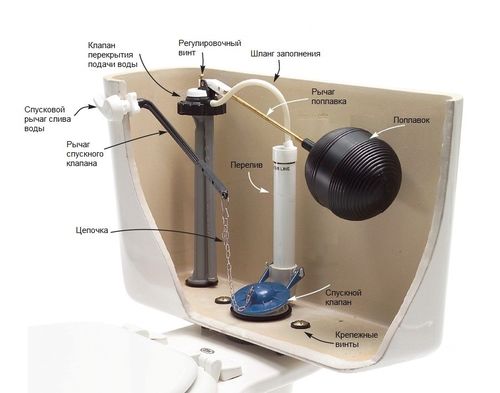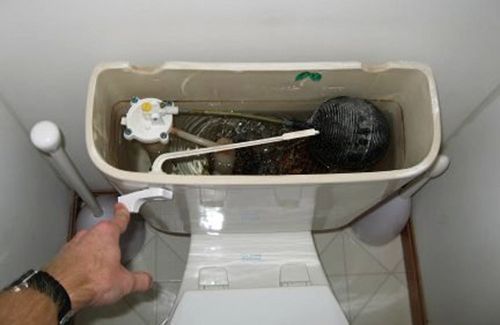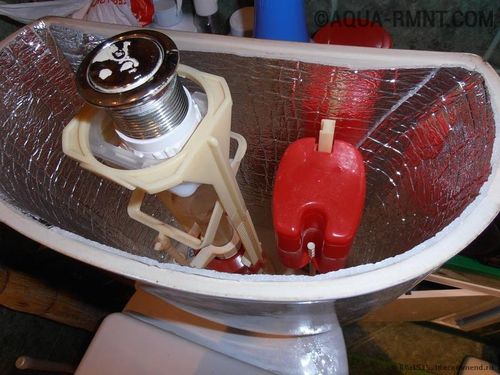The toilet is one of the most important devices in the house, the importance of which we realize only after it has failed. There are a variety of breakdowns that may not allow you to use the toilet in full mode. But then we will consider a characteristic problem that occurs quite often even in modern models - water flows in the toilet. For clarity, we will give a photo, as well as detailed instructions with a video on what to do.
But first, let's deal with the toilet device. This will allow you to more accurately understand the cause of the breakdown.
Components
Toilet - cistern and bowl. The work of the first is based on the principle of a water seal. Includes such elements: lever system, float and seal. When a button is pressed or a lever is lifted (depending on the design), the water drains into the bowl, taking all impurities with it into the sewer. After that, the tank is filled until it is full. After reaching a certain level, the valve closes the water supply.

If a lever is provided for flushing, you need to unscrew the handle, and then remove the lid. If there is a button instead of a lever, turn the decorative ring counterclockwise. The button will come with a plastic pin, threaded on it for fixing. In some cases, fasteners are additionally provided, then they need to be unscrewed.
You need to carefully remove the tank lid, since this is a rather fragile element, if it breaks, you will have to change the entire toilet bowl. Of course, the design may differ for each manufacturer, but in general, the schemes are quite similar.

Faults
Usually, all possible malfunctions with a toilet bowl have the following symptoms:
- water constantly flows into the bowl;
- liquid continuously flows from the plumbing system into the tank;
- the toilet itself is leaking;
- flush button broken
- repeated pressing of the button is required in order for the drain to occur or the liquid to stop flowing into the tank.
To eliminate the breakdown, it is very important to determine its cause.

First option
Overflowing the tank is the likely reason why water is constantly flowing. All "extra" water goes into the bowl through the overflow.
Let's highlight a few reasons for this problem:
- valve crack (found only in plastic products);
- problems with the pin holding the float lever;
- low gasket pressure;
- its wear.
Understanding the reasons, you can roughly figure out how to act.
How to solve:
- We remove the cover.
- Raise the float a little. The flow must end. If this happens, it will only be necessary to slightly bend the lever in order to ensure that the water supply is shut off.
- If it doesn't help, you will have to inspect the valve. Instead of a broken stud, you can use a piece of copper wire. If the hole in which it is attached has become large, the entire valve will need to be replaced. To do this, you should take a sample of the old one with you to the store in order to find exactly the same one.
- If the gasket is worn out, then the entire valve will still need to be replaced, since they are not sold separately.

Second option
Consider the option in which water flows, and its level in the tank is less than the overflow. A common cause is a broken bolt that tightens the toilet and shelf. A similar problem existed especially acutely in older models, where there was a pair of steel bolts. Naturally, under the influence of water, they quickly became unusable. In this case, they need to be replaced. Moreover, it is desirable to choose products from corrosion-resistant materials.
You can solve the problem by disassembling and assembling the tank:
- turn off the cold water supply;
- remove the tank cover;
- empty it;
- disconnect the flexible hose;
- we unscrew the bolts that fix the shelf on the toilet: if it doesn’t work, you can use a hacksaw;
- tilt the tank back to get the shelf out of the cuff;
- drain the remaining liquid, lay the tank on a flat surface.
After replacing the bolts with new ones, everything should be assembled. At the same time, it is important to replace the rubber elements so as not to return to repair in the near future.
When tightening the bolts, be careful not to over tighten. The toilet material breaks quite easily.

Third option
What to do if the bolts are intact, there is a lot of space before overflow, and the liquid flows. When there is water in the tank, it does not flow into the bowl as long as the rubber bulb holds it. By pressing the button, the pear rises, the liquid flows out. Over time, the material from which it is made loses its qualities, which means that there is every chance that the pear will begin to let water through.
It is necessary to change the pear. It is fixed on the stem with a thread. You can unscrew it by turning it counterclockwise. You need to go to the store with a sample of the old product in order to pick up an identical one.
A temporary solution could be some kind of weight hung on the stem to press down the rubber, preventing the liquid from constantly flowing out.
Summing up
As you can see, there are not so many reasons why water can flow in the toilet. Therefore, even an unprepared person can cope with the problem, in principle. It is only important to carefully read the instructions, as well as act consistently and accurately. Then everything will work out - the toilet will work without failures.


















